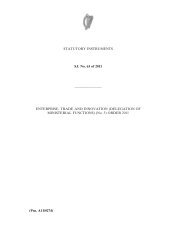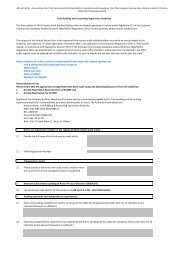View - Esma
View - Esma
View - Esma
Create successful ePaper yourself
Turn your PDF publications into a flip-book with our unique Google optimized e-Paper software.
Rationale for the enforcement decisionThe enforcer questioned whether the non – CEO members of the Executive Board of the two main subsidiariesshould also be considered as key management personnel and hence be treated as related parties, in accordancewith IAS 24.The issuer explained that the reason for identifying key corporate officers lay solely in the provisions of theprospectus directive which require an entity to demonstrate that management is capable of running thebusiness. The issuer felt it could only satisfy the requirement by providing the required information for boththe members of the Executive Board of the parent and all Executive Board members of the two mainsubsidiaries. The Issuer has clarified that this does not mean that the non – CEO Executive Board members ofthe main subsidiaries are also key management personnel and hence meet the definition of a related party;these other individuals do not participate in the board meetings of the parent company and hence, do not havethe authority or responsibility for planning, directing and controlling the activities of the parent, eitherdirectly or indirectly. However, the Company has confirmed that they do have authority and responsibility forplanning, directing and controlling the activities of the two main subsidiary companies.The issuer also indicated that it had looked at how its peers define key management personnel and that theyusually appear to restrict this to the members of the Executive Board of the parent company.IAS 24 paragraph 9 states that a party is related to an entity if the party is a member of the key managementpersonnel of the entity or its parent. Key management personnel is further defined as those persons havingauthority and responsibility for planning, directing and controlling the activities of the entity, either directlyor indirectly, including any director (ie executive or non-executive) of that entity.In reaching its conclusion the regulator took account of the following:a. The issuer’s confirmation that the non-CEO Executive Board members of the main subsidiaries havethe authority and responsibility for planning, directing and controlling one of the two main activitiesof the group at subsidiary level. This is also supported by the description of their roles andresponsibilities as included in the prospectus. Consequently they have authority and responsibility forplanning, directing and controlling the activities of the entity;b. The fact that key corporate officers do not participate in the parent company’s board meetings doesnot mean that they cannot be considered key management personnel. An entity may have more thanone level of key management.c. That other companies appear to restrict key management personnel to members of the executiveboards of parent entities does not preclude other individuals from satisfying the definition of keymanagement personnel. Designation is determined by the particular facts and circumstances of theindividual case.* * *Decision ref.EECS/0508-10: Internally generated intangible assetsFinancial year end: 31 December 2006 / Annual Financial StatementsCategory of issue: Intangible Assets, Research and DevelopmentStandard involved: IAS 38Date of the decision: 12 October 2007Description of the issuer’s accounting treatmentAs at 31 December 2006, 51% of the issuer’s total assets were represented by mainly internally developedintangible assets comprising the capitalised expenses of the acquisition and production of electronic map data.The intangible assets generate 100% of the issuer’s revenue.The issuer had constructed a database of electronic maps. On a worldwide level the data is sufficiently detailedfor routable purposes (i.e. calculation of distances for planning purposes). At national level, the information ismore specific, allowing customers to use the information for satellite navigation purposes (i.e. to plot theoptimum route from A to B). The issuer modifies electronic maps from its database to match customerspecifications, so that the maps run on their own devices.The costs incurred in bringing the information about a certain region to a higher standard of performance arecapitalised. The costs related to maintaining the information about a certain region at that same standard ofperformance are expensed to the income statement.- 12 -










